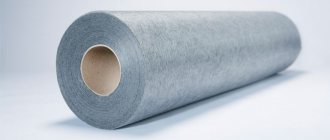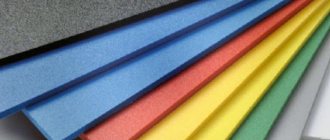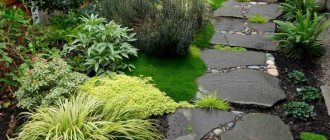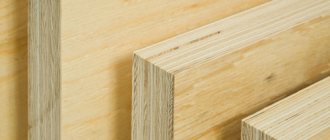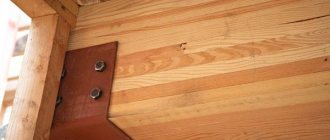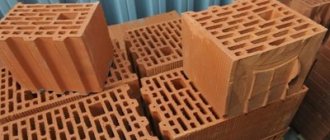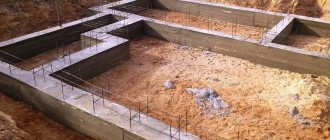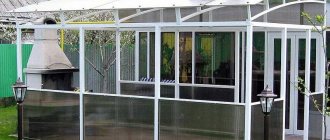As an advertisement
If for professional builders the importance of geotextiles is like an axiom: obvious, proven and undeniable, then private developers are not well enough aware of all the possibilities of this unique material. This picture does not always develop, but quite often. The use of geotextiles in private construction is not so uncommon (rather, on the contrary). But, unfortunately, this material is used quite rarely correctly and for its intended purpose.
It is very easy to make a mistake in choosing geotextiles. Therefore, very often, not only those who completely abandoned this material, but even those who were able to find use for it on their own personal plot have to regret missed opportunities. Paradox? Yes. But the explanation for such an intricate curiosity is very simple: geotextiles are not a finishing solution, which, if it does not correspond to the chosen style, can always be changed (if desired). This is the material that forms the basis, and if the geotextile was chosen incorrectly, then even the most expensive and high-quality material will bring nothing to the owner except costs and disappointments.
Avoiding superficial judgments, we will try to delve into the very essence of the problem. Let's find out, for example, why for the construction of an access road it is necessary to use Dornit geotextiles with a density of 350 g/m2, and not some other? Why is it undesirable to use this same material in the construction of drainage sewers? There are many questions, and so that the most important information is presented logically and consistently, let’s get acquainted with the types and features of the use of geotextiles.
General concept of geotextiles
By definition, geotextile is a special type of synthetic fabric that is manufactured using various technologies and has different physical characteristics. Manufacturing technology and material density are the key factors that determine the final purpose of the geosynthetic fabric. Geotextiles are used:
- in road construction:
- in private and industrial construction;
- in agriculture and even in medicine.
Nowadays, geotextiles are increasingly used in landscape design and private construction:
- Being part of drainage systems, geotextiles protect the perforation of underground pipes from clogging, and bulk materials from mixing with the soil and from spreading (thereby it extends the service life and increases the efficiency of drainage communications).
- The use of geotextiles during the construction of the foundation is an opportunity to provide additional reinforcement of the base. Strengthening the underlying layer (for example, sand bedding), protecting it from mixing with natural soil - all this helps to reduce the consumption of building materials and reduce construction shrinkage.
- During the construction of a roadway, geotextiles protect crushed stone from mixing with the soil, thereby allowing the thickness of the asphalt pavement to be reduced without losing its quality (the same functions are performed by geotextiles during the construction of pedestrian paths).
- It is completely impossible to imagine the improvement and decoration of a personal garden without geotextiles. It provides mechanical protection for film waterproofing used in the construction of reservoirs. Geotextiles also help protect decorative hills or landscape terraces from crumbling. Geosynthetic fabric increases the load-bearing capacity of the soil by an order of magnitude, and this quality is in demand wherever there is a need to strengthen bulk layers or protect materials susceptible to mechanical damage.
The nuances of calculating the required quantity for installation
The main characteristics of the canvas are width, length and area. The width of the product ranges from 1 to 6 m. On average, winding 1 roll is 100 m. Depending on the manufacturer and the density of the fabric, this figure may vary. The area is indicated on the packaging (area, m² = length x width).
The consumption of the canvas is affected by the specifics of installation. When draining, the length and width of the pipe are taken into account. The required reserve is up to 15 cm on each circle. When fixing textiles to the base, you should always take a small margin, especially if the surface is uneven.
Raw materials for the production of geosynthetic fabric
Most often on sale you can find geotextiles made from polyester and polypropylene fibers. Thanks to its high strength and durability, polymer geotextiles have gained popularity in the construction industry and agriculture - where these qualities are valued most.
Less common are geotextiles made of fiberglass and various natural inclusions (textile industry waste: cotton, wool, etc.). The use of natural fillers somewhat limits the scope of application of the material. Such fabric, for example, is not recommended for use in the construction of drainage communications, since it quickly wears out, and this leads to clogging of drainage systems.
Polypropylene geotextile
Geo-fabric made of continuous polypropylene fibers is a material based on a thermoplastic polymer with increased chemical resistance. Polypropylene fibers are a product of the polymer industry, which is a primary, that is, unprocessed raw material. The use of solid fiber gives the fabric high strength, but when exposed to sunlight, polypropylene threads quickly lose their strength. This problem is fixable: by adding chemical stabilizers to the product that protect it from exposure to ultraviolet radiation, polypropylene geotextiles are successfully used in a wide variety of areas of human activity. The relatively high cost of polypropylene geotextile is a consequence of the technological features of production.
Dimensions
The width of such rolls is fixed and is usually 430 cm. However, modern developments on the sales market can already reach 5 m or more. The length is often used at 100 linear meters, so the weight of the purchase is significant.
Rolls of geotextile
The thickness of the raw material varies from 0.8 to 1.8 mm at minimum loading pressure and from 2.4 to 3.8 mm at 2 kPa. The steps of testing activities and their smallest details are very strictly regulated by state standards, so there is no need to fear any problems or incorrect technical indications.
Important! In this material, thickness and density are directly proportional - thick textiles will be many times more effective than thin ones.
Polyester Geotextile
Polyester geotextile is a material made from short polyester fibers. They are based on recycled materials (plastic waste, polymer production waste, etc.), which significantly reduces the cost of the canvas, but gives it sufficient strength.
A suitable example of quality, durability and practicality is Dornit brand polyester geotextiles with a density of 250 g/m² - a popular and economical solution for low-rise construction, landscape design and complex landscaping of homestead areas.
With this, the classification of geotextiles based on materials of manufacture can be completed. There are not so many options, and their differences are clear even to the uninitiated.
The situation with production technology is much more interesting, because the area of application of geotextiles depends on it.
Based on the manufacturing method, geotextiles are divided into two main types: woven and non-woven.
Where is it used?
As described above, the versatility and practicality of geotextiles allows it to be used in many areas of life. Thus, the heat-treated product will be indispensable for arranging green roofs, drainage systems, homesteading, soil reinforcement, etc.
Garden landscape
Formation of personal territories using geotextile
Previously, in order to arrange paths and areas on the territory of country apartments, a standard laying of a cushion of sand and gravel was used, tiles or paving stones were laid in a pre-dug hole and on top. With intensive use, heavy watering or significant amounts of precipitation, the paths sagged, cracked, roots and sprouts grew through them, pushing apart and disturbing the laid decorative layer. Now the hard work and subsequent maintenance is simplified through the use of geotextile fabric:
- It is placed between the layers that form the flooring, thereby preventing them from mixing;
- Promotes proper load distribution, so that the plane does not settle;
- Promotes immediate drainage of water and slows down soil erosion, even in areas with high concentrations of liquid or marshy areas;
- No plants can grow through the fibers;
- The layer reduces the amount of raw materials for the formation of bulk tiers.
Geotextiles for paving stones
In addition, the fabric solves other problems:
- Protects plants from frost if covered for the winter;
- Preserves the fertile layer for a long time, preventing it from being washed out;
- It is used to create landscape compositions, flower beds, alpine slides and more.
Laying a layer on top of the soil
Formation of reservoirs
Few people do not use fountains and artificial ponds to decorate their courtyards and surrounding areas. The waterproofing membrane performs an effective protective function and is laid on the bottom and walls of the bowl before it is filled with water. But a change in the shape of the soil surface, tree roots, damaged concrete or stones can break through the moisture-retaining layer. To do this, a layer of geofabric is laid between it and the ground. To make the structure even more reliable, a second flooring is also installed above the waterproofing.
Creating water compositions using geotextiles
The function of technical fibers does not end there. They block the bloom of water, prevent sand or pebbles from concentrating in one place, and also prevent the walls from collapsing and strengthen the overall structure, so that you can safely move along it during maintenance or cleaning work.
Geotextile is indispensable for the construction of swimming pools
Construction of a sewer system
Drainage sewers perform the functions of removing moisture in areas with high groundwater levels. To prevent soil washout and soil erosion, finely perforated pipes are laid. The sewage system will last a much longer time if geomaterial is used in its implementation. Durable, it has a water-permeable structure, and due to the texture of the fibers it prevents clogging of micro-holes in pipelines.
Application for sewerage installation
Textiles for drainage must be durable so as not to tear under the enormous pressure of the pillow and the soil poured on top, but at the same time the pores must allow liquid to pass through. Holes that are too small will quickly become clogged with earth particles, so the optimal fiber density will be 100-200 g/m2.
To create a drainage system using geofabric you need:
- dig a trench;
- fill its bottom with sand;
- lay geotextiles over the sand layer, the edges of which should extend beyond the proposed structure by at least 1 m;
- then a bed of fine-grained gravel 20-30 cm high is poured and a pipeline is laid, on top of which gravel is again poured;
- at the end, the remaining loose fabric is wrapped around the pipes and the remaining space is filled with earth.
Roof waterproofing
Technical fibers are used to protect waterproofing from mechanical damage. To do this, it is laid on both sides of the moisture-proof tier. Geofabric is also applicable for arranging green roofs, where it performs the same functions as in garden design - its fabric is laid under a bulk layer of earth.
Roof waterproofing with geotextiles
Separation and protection
The structure of the fabric makes it possible to separate bulk pillows made of different materials. Fibers delimit layers of crushed stone, sand embankment, and soil, which prevents them from mixing and losing their original qualities. This is relevant during the process of laying road surfaces. Firstly, the load from moving cars is distributed evenly, preventing the formation of cracks and subsidence of the asphalt. And the filtering effect helps to separate moisture and prevents the fabric from blurring.
Separation of bulk layers using geotextiles
The density of geotextile rolls is chosen based on the future operational load. For passenger cars, 250 g/m2 is enough, for trucks - from 300. Federal highways require the use of 400 g/m2, and on runways an even thicker layer is laid.
Hydro objects
The material has also found wide application for objects under the constant influence of liquid - bridge supports, construction of dams, dams and breakwaters. To provide reliable protection from exposure to fresh and salt water, a high-strength layer is required. In this case, thermally bonded polypropylene geological textiles are used.
Construction of dams and hydraulic fortifications
How to count the quantity
Having understood the physical and chemical properties of geological textiles, you need to know how to determine the necessary material requirements for each specific case. Correct calculations will allow you to avoid purchasing both excess and missing quantities of the product. In order to carry out a mathematical calculation correctly, you need to take into account some factors that can affect the final figure:
- The base, without preliminary preparation, like an embankment, is covered in carefully planned terrain areas, between the lower part of the slopes. The fly width of the sheets should be in the range from 200 to 300 mm, but if anchors will be placed, then this area is covered with overlapping sections of 350 mm.
- To drain water masses, the above value is taken as 150 mm. Another additional factor is the cross-section of the pipes, which are covered with textile components. When installation is carried out on a raised base, it is advisable to leave 200-300 mm in reserve - this will make it possible to ensure that there are no unexpected unpleasant moments during the work process. When preparing sidewalks and stone paths, their own area is first calculated, and then the resulting number is divided by linear square meters of a piece of geotextile.
Woven geotextile
Woven geotextiles (geofabric) are made using classical technology, which is based on the mutual interweaving of longitudinal and transverse fibers. This material has high tensile strength and can withstand breaking loads well. These qualities determine the area of application of geofabric:
- construction of reinforced earth embankments;
- arrangement of retaining fortifications;
- arrangement of foundations with complex configurations;
- road construction;
- complex construction work, construction of engineering infrastructure and so on.
Varieties
The following types of geotextiles exist:
- Needle-punched. Its base consists of tiny fibers of polyester or polypropylene, fastened together with a needle-punched method. Due to this technology, a structural fabric is formed that can pass water only along and across. During the operation of geotextiles, its structure is not filled with water and is not clogged with earth elements.
- Heat set. It consists of structural fibers that are firmly fused together at the production stage. But the material has poor filtering properties, but has high strength.
- Heat treated. A type of geotextile that is produced by pressing components with their simultaneous fusion. This creates a durable fabric used for waterproofing.
- Knitted. It is based on polypropylene and polyester fibers, which are stitched with strong threads. The resulting geofabric is highly permeable to moisture, but has poor resistance to external influences.
- Building. Designed for waterproofing certain structures on site. It is not affected by moisture, does not accumulate and allows water to pass from the inside to the outside.
Non-woven geotextile
Non-woven geotextiles, in turn, can be thermally bonded and needle-punched. In the first case, geotextile fibers are bonded together under the influence of high temperature, in the second - under the influence of a mechanical press with needles.
Thermally bonded geotextiles are made exclusively from polypropylene fibers. This determines its main qualities: strength and elasticity.
Thermally bonded geotextiles are successfully used to strengthen the soil during construction on slopes. Also, its qualities can hardly be overestimated if you are planting trees or improving plant areas (it retains moisture well, thereby allowing you to increase the intervals between watering plants by an order of magnitude). But due to the low filtration coefficient, this material should not be used in the construction of drainage communications, because it allows water to pass only in the transverse direction.
Should I replace it with roofing felt?
Some builders use roofing felt and galvanized metal mesh for reinforcement instead of geotextiles. However, even taken together they cannot be compared with modern geotextiles in terms of durability. If roofing felt lasts only 20 years (and then in the best case), then geotextiles, which are entirely made on the basis of polypropylene fibers and processed by thermosetting, have a service life of 80-100 years!
So it is possible to replace geotextiles with roofing felt, but is it necessary?
Source
Needle-punched geotextiles are an indispensable solution for private construction
To produce needle-punched geofabric, both short and continuous polymer fibers are used. The mechanical method of fastening fibers simultaneously gives the fabric both strength and a high filtration coefficient. This significantly expands the scope of its application. Considering that modern technologies make it possible to produce material with specified density parameters, it is difficult to find a more suitable synthetic fabric for private construction than needle-punched polyester geotextiles.
Density of geotextiles and areas of its application
For private construction, for work related to landscaping, as well as for the construction of temporary local roads, construction experts recommend using Dornit needle-punched polyester geotextiles, the density of which varies from 150 to 350 g/m².
On the one hand, this material is inexpensive, thanks to which the average private developer can purchase it without any problems, on the other hand, the characteristics of the material fully correspond to the listed areas of application. The Dornit classification by density has a step of 50 g/m², and each subsequent classifier step has its own narrowly targeted purpose.
To understand how to choose the right fabric based on density, let’s look at several examples of the intended use of needle-punched geotextiles.
Adviсe
Geotextiles are innovative products, the name of which indirectly reflects its characteristics. So, for reinforcing and hardening soils, geofabric is ideally suited; for underlying embankment levels, it is advisable to use geofabric. Drainage work does not allow any use of such products on a natural basis. Organic threads, even in minimal quantities, will quickly succumb to the process of rotting and will reduce the entire installation to nothing. Also unsuitable for drainage is fabric connected by thermal method. Experts for such events recommend a textile layer of medium thickness.
Arrangement of slopes
Important! Using geotextiles as a weed killer, the latter need to be cut off at the root, and only then the sheets should be laid.
In order to prepare the garden plot, 150 mm of sand or half as much crushed stone is poured over the textile lining. It is advisable to carry out similar procedures where planting is not planned in the near future. The ideal solution would be a combination of natural rest of the land with technological weed control. The latter, in the process of decomposition of the root system and shoots of weeds, will be saturated with organic matter and its fertile layer will increase. The first planting of plants on the renewed soil can be done within a year.
Preparing the garden plot
Under sidewalks, geological fabric sheets should have a density of 150 g/m2. It is with these indicators that they will be able to withstand all operational loads. Non-woven products cannot be used for this type of work.
Geotextile with a density of 150 g/m²
Geotextile "Dornit" 150 g/m² was developed specifically for the construction of drainage systems and for strengthening the soil when organizing drainage communications. The small pores of denser geotextiles quickly become clogged with solid microparticles of soil, thereby reducing the filtering capacity of the material. At the same time, the material, with a density of 150 g/m², is ideal for drainage and excellently strengthens weak foundations.
Geotextile with a density of 200 g/m²
Geotextile "Dornit" 200 g/m² is designed to strengthen unstable and weak soils. It is used in the following situations:
- when it is necessary to arrange a lawn on a personal plot: to stabilize the soil or protect the soil from deformation;
- when it is necessary to strengthen an unused embankment;
- during the construction of pedestrian paths and decorative slopes.
Most often, people who engage in landscape design use material with a density of 200 g/m². With its help, you can effectively separate layers of soil in unexploited areas or protect lawns from the germination of weeds.
DIY installation rules
Laying geotextiles is carried out in 2 ways:
- longitudinal;
- transverse.
When working independently, the first method is easier. The second one is easier to implement with the help of special equipment.
Installation is carried out in several stages:
- Cleaning the surface of weeds and debris, leveling.
- Rolling out. The rolls are unrolled manually gradually. Uniform installation will require the efforts of 2 or 3 people. To prevent the coating from moving, it is secured to the ground with anchors. The strips at the joints can be fixed using a gas torch. The fabric is overlapped with a margin of up to 20 cm or more.
- Filling with crushed stone or other bulk material, leveling.
Geotextile with a density of 250 g/m²
Needle-punched geotextiles with a density of 250 g/m² are chosen by those who plan to undertake large-scale construction work on their own personal plot. This material is optimal for strengthening the soil under the foundation by laying a sheet under a sand cushion. It reliably separates the shock-absorbing bedding from the main soil and allows you to evenly distribute the loads along the entire perimeter of the foundation. At the same time, Dornit 250 g/m² is successfully used to strengthen blind areas, as well as for mechanical protection of polymer film used in the construction of swimming pools and artificial reservoirs.
Geotextile with a density of 350 g/m²
Needle-punched geosynthetic fabric, with a density of 350 g/m², has also become widespread in private construction. This material is most suitable for the construction of reliable access roads, car parks or massive foundations. It can also be used to solve other problems that have a similar purpose and corresponding level of complexity.
The main advantages of Dornit brand needle-punched geotextiles
The key advantages of the presented material lie in the almost unlimited scope of its application, as well as in the unchanged performance characteristics throughout the entire period of operation (which, by the way, reaches 25 years). It is characterized by:
- strength and durability, which are achieved by using non-degradable geosynthetic materials;
- resistance to vibrations and temperature changes;
- good filtering ability even under extreme operating conditions (intense vibrations, strong mechanical pressure, etc.);
- environmental friendliness and affordable cost.
By the way, about the cost: the price of the material includes all the costs that are required by impeccable adherence to production technology, the cost of purchasing high-quality raw materials, as well as the cost of operating high-tech production equipment. If you like geotextiles that are too low in price, it means that one or another cost item is not included in its cost. Consequently, the material was produced in violation of technology or using low-quality raw materials.
It is impossible to create high-quality material without appropriate investments, so cheap geotextiles will have neither reliability nor durability. By purchasing geosynthetic fabric from official dealers who directly cooperate with the manufacturer, you will always receive guaranteed quality at a reasonable and reasonable cost.
Subscribe to our Telegram channel Exclusive posts every week
